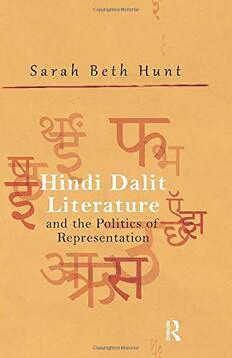
Hindi Dalit Literature and the Politics of Representation PDF
Preview Hindi Dalit Literature and the Politics of Representation
Hindi Dalit Literature and the Politics of Representation This page intentionally left blank Hindi Dalit Literature and the Politics of Representation Sarah Beth Hunt LONDON NEW YORK NEW DELHI First published 2014 in India by Routledge 912 Tolstoy House, 15–17 Tolstoy Marg, Connaught Place, New Delhi 110 001 Simultaneously published in the UK by Routledge 2 Park Square, Milton Park, Abingdon, Oxon OX14 4RN Routledge is an imprint of the Taylor & Francis Group, an informa business © 2014 Sarah Beth Hunt Typeset by Solution Graphics A–14, Indira Puri, Loni Road Ghaziabad, Uttar Pradesh 201 102 All rights reserved. No part of this book may be reproduced or utilised in any form or by any electronic, mechanical or other means, now known or hereafter invented, including photocopying and recording, or in any information storage and retrieval system without permission in writing from the publishers. British Library Cataloguing-in-Publication Data A catalogue record of this book is available from the British Library ISBN 978-0-415-73629-9 Contents Acknowledgements vii Introduction 1 1. The Beginnings of Dalit Literature in Hindi: The Field of Dalit Pamphlets 25 2. Writing Dalit History 83 3. The Rise of the Autobiographic Field of Hindi Dalit Literature 132 4. Dalit Autobiography: Personal Pain as Political Assertion 176 5. The Meaning of Dalit Literature 209 Conclusion 245 Bibliography 247 About the Author 260 Index 261 This page intentionally left blank Acknowledgements I would first like to thank my PhD supervisor, Dr Francesca Orsini, for her incredible support and insight throughout the many years of this project. She truly invests her heart and soul into her students, and I only hope I can pass along the kindness and inspiration she has imparted. She also taught me my very first Hindi words. I would like to express my gratitude to the Smuts Fund, Rapson Fund and Trinity Hall for their financial support over my years at Cambridge and during several visits to India for fieldwork. The Faculty of Asian and Middle Eastern Studies and the Centre of South Asian Studies were havens at Cambridge, particularly thanks to Dr Eivind Kahrs and Dr Sudeshna Guha, who are more than colleagues or mentors, but family as well. I certainly could never have completed this project without the unfailing help and guidance of Professor Purushottam Agrawal at Jawaharlal Nehru University, and my bril- liant research assistant Kavitendra Indu. I cannot qualify the extent to which he has helped in along the way. Thanks to my many friends, especially Rachel, Justin and Ben from the University of Cambridge, who helped me keep my humour and made the fieldwork trips for this project real adventures. I would particularly like to thank my great friend Dr Rachel Berger. In the solitary work of research projects and the long process of writing everyone needs at least one intellectual soulmate who reminds them why their work is interesting and keeps them not only sane but ins- pired to keep working. Rachel is that person for me. And, of course, thank you to my partner Steven and my parents for their unwavering support over the years. These acknowledgements would be far from complete without my expressed thanks to all the Hindi Dalit writers who invited me into their homes and shared their thoughts and dreams about their writing. Their work can never be reduced to simple words on a page to be read and analysed by academics and literary critics. It is the result of years of resilience in the face of real oppression and the expression of hope that change is indeed possible. I hope that this book does them justice. This page intentionally left blank Introduction O n 14 April 2004, the broad street of Sansad Marg in Central Delhi was filled to its capacity with smartly-dressed families laugh- ing, eating, meeting friends, visiting booths and buying festival paraphernalia. It was Ambedkar Jayanti — the most important contemporary festival of the Dalit community. From every angle, one’s vision collided with the colourful portrait of the most beloved Dalit leader, Dr Bhimrao Ramji Ambedkar, smiling from framed pictures, small T-shirt buttons and banners rippling atop decorated trucks. As one of the most marginalised and oppressed communities in India, it has taken decades of struggle for Dalits to celebrate their identity in such a public way. The continual marginalisation of Dalits is perhaps no more apparent than on the occasion of Ambedkar Jayanti, as Dr Ambedkar, Father of the Indian Constitution, contin- ues to be commemorated only by members of the Dalit community. Celebrated next to the Indian Parliament at the heart of the nation’s capital, Ambedkar Jayanti symbolically represents the community’s fight to claim a central place in the nation. Over the past several decades, the Bahujan Samaj Party (BSP) has made similar efforts to defend the position of Dalits at the centre of political power and has increasingly politicised Dalit identity across both urban and rural north India. In the cultural arena across India, Dalit writers have presented an equally important challenge to the dominant representations of the lower castes in Indian society. In the north, Hindi Dalit litera- ture has gained widespread recognition as a powerful new literary movement, with mainstream Hindi commercial presses publishing Dalit autobiographies, short stories and literary criticism written by some well-established Hindi Dalit writers. Hindi Dalit literature is also gradually being incorporated into the curriculum of a few north Indian universities and is beginning to gain international rec- ognition through several recent English translations of Hindi Dalit autobiographies and short stories.1
